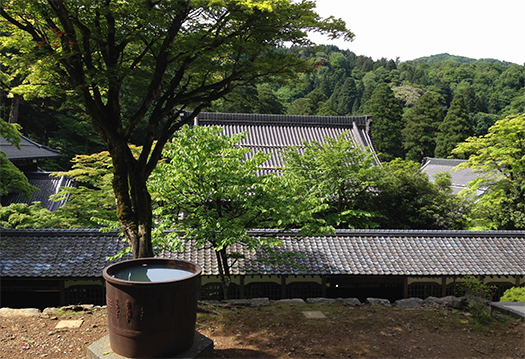


曹洞宗の寺院として能登の總持寺と移転先の横浜鶴見の總持寺の両方を見た。
とくに鶴見は首都圏出張時の定宿町なのでときどき参観しております。
しかしさすがに永平寺は一度しか参観機会はない。
知名度的には非常に高いけれど、福井県というのは北海道人にはかなり遠隔。
京都が首都だった時代には、そこからの距離感覚的には
そこそこの独立性と権威性を示すことができる立地位置なのでしょう。
こういった状況も掘り起こし的に見えてくる。
京都が首都の時代には「北国」とは琵琶湖を越えた以北、という感覚であり
蝦夷地というのはまったくの異郷、北極のようなイメージか。
そういう北国イメージからはその中心として永平寺はあったように思える。
たぶん歴史的に福井は海外交易の拠点のひとつであり
日本海航路で半島〜大陸との関係性が深い地域認識が優勢だったのかも。
今回の探訪記で、追体験的に写真整理して思わぬ情報も拾い出せて有意義。
いくつかの建築群が回廊で連結されているけれど、その最高立地には法堂。
本尊3体が置かれる仏堂よりもさらに上に修行の場を置いている。
やはり「禅修行を第一とする」姿勢を表しているように思います。
昨日見た仏堂が基壇基礎という建築であるのに対して
その上位建築として床上げした日本的な寺院建築。
1843年の改築記録が残る永平寺七堂伽藍中最大の建築。
間口18間・奥行き14間、約420畳敷き。
本来目的は説法の道場だけれど現在は朝課(朝のお勤め)が行われる。
わたしは永平寺では朝課を見たことはありませんが、
鶴見の総持寺では朝早くからの朝課をときどき参観させていただくことがある。
禅修行寺院としての荘厳な気風を感じさせていただく。
多数の僧侶による読経の様子は曼荼羅世界を想起させてくれるし
その音楽性の多彩さに驚かされたりする。
たぶん日本人に仏教が浸透していった理由のひとつがそうしたイベント性。
多彩な音楽性や、香による五感訴求、僧侶さんたちの集団演舞が
混然一体となったものとして信仰心を刺激したのではないか。
来世の存在を信じさせるにはいい機縁を提供していたと思う。

で、わたし的に永平寺での景観としてこの法堂の縁から見晴らす
景観美、とくに一番上の写真の情景がこころに残り続けている。
English version⬇
[Hodo, the center of Zen training temple, Eiheiji-9]
As a temple of the Soto sect, I saw both Sojiji Temple in Noto and Sojiji Temple in Tsurumi, Yokohama.
In particular, Tsurumi is a regular lodging town for business trips to the Tokyo metropolitan area, so I visit it from time to time.
However, as expected, Eiheiji has only one chance to visit.
Although it is very well known, Fukui prefecture is quite remote from Hokkaido people.
When Kyoto was the capital, the distance from it was sensuous.
It is a location that can show decent independence and authority.
This kind of situation also seems to be digging up.
In the era when Kyoto was the capital, “northern country” was a feeling that it was north of Lake Biwa.
Is Ezo an image of a completely foreign country, the Arctic?
From such a northern image, it seems that Eiheiji was the center of it.
Perhaps historically Fukui has been one of the hubs of foreign trade
Perhaps the area recognition that has a close relationship with the peninsula and the continent was predominant on the Sea of Japan route.
In this expedition, it is meaningful to be able to recollect the photos and pick up unexpected information.
There are several buildings connected by a corridor, but the best location is the temple.
The place of training is placed above the Buddhist temple where the three principal idols are placed.
After all, I think it expresses the attitude of “putting Zen training first”.
Whereas the Buddhist temple I saw yesterday is an architecture called the foundation of the foundation
A Japanese-style temple building with a raised floor as a higher-level building.
The largest building in the Eiheiji Shichido Garan, which has a record of reconstruction in 1843.
Approximately 420 tatami mats with 18 frontages and 14 depths.
Originally the purpose was a dojo of preaching, but now the morning lesson (morning work) is held.
I have never seen the morning lesson at Eiheiji,
At Tsurumi’s Sojiji Temple, I sometimes visit the morning lessons from early in the morning.
I feel the solemn atmosphere of a Zen training temple.
The state of sutra chanting by many monks is reminiscent of the mandala world.
I am amazed at the variety of musicality.
Perhaps one of the reasons why Buddhism has permeated the Japanese is such an event.
A variety of musicality, appealing the five senses with incense, and group performances by monks
It may have stimulated the faith as a mess.
I think it provided a good opportunity to make people believe in the afterlife.
So, I personally look out from the edge of this temple as a landscape at Eiheiji Temple.
The beauty of the landscape continues to remain in the heart.
Posted on 12月 6th, 2021 by 三木 奎吾
Filed under: 住宅マーケティング, 日本社会・文化研究







コメントを投稿
「※誹謗中傷や、悪意のある書き込み、営利目的などのコメントを防ぐために、投稿された全てのコメントは一時的に保留されますのでご了承ください。」
You must be logged in to post a comment.